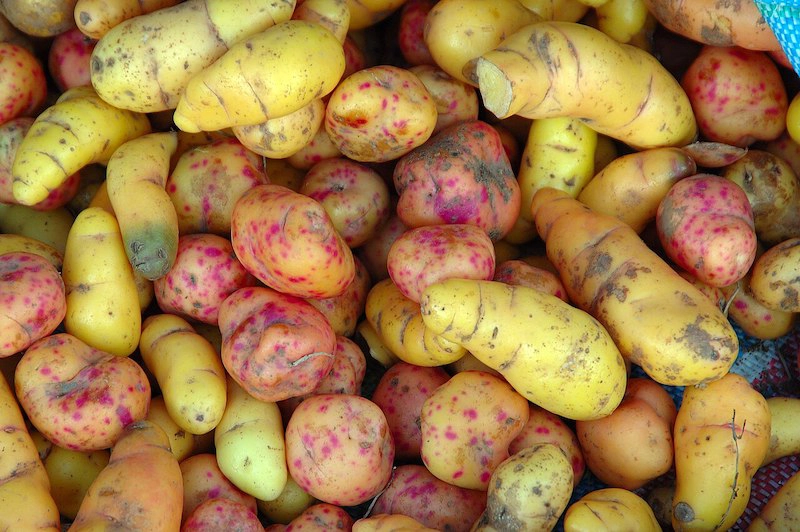‘What are those things, anyway?”
“They’re geophytes.”
“Well, that didn’t help much.”
Okay, geophytes are perennial plants with underground food storage organs. Bulbs are the fourth geophyte. Geophytes aren’t just plants with big roots. The storage organs are in addition to roots, occurring between roots and top growth.
This obviously gives them an advantage since they bring their own lunch, so to speak. As long as the leaves of geophytes are green, don’t remove them when the flowers are spent. The leaves will continue to nourish the underground storage unit until they begin to turn yellow and die.
Although geophytes produce seeds, you’ll usually have better luck propagating them by offsets in the case of bulbs and corms, and by dividing tubers and rhizomes. Actually, you can successfully divide bulbs and corms, too, by cutting them into halves or quarters, making sure that each piece has some of the basal plate (from which the roots will grow).
Let’s talk about some of the most successful geophytes. The easiest to grow is probably the potato. So easy that children often do it for school projects. Left to their own devices, potatoes will start growing right in your cupboard. No wonder they’re the most successful tuber in the world. Do you remember poking toothpicks into a sweet potato to hold it up in a glass of water? Probably your first experience as a gardener. It was mine. The potato was big and the vine climbed along the top of the kitchen wall until my mother pulled it down because “there might be bugs hiding in it and fall into our soup.” Unlikely, but you know Moms.
Other tubers include the fabulously beautiful climbing Gloriosa Lily. Plant the tuber horizontally about 3 inches deep under the outside edge of a shrub and you’ll have a living, compatible trellis for it to climb upon. The tubers are very slow to grow large enough to share, so if you have one, treasure it. They’re pricy.
Dahlias, on the other hand, are enthusiastic reproducers, and can successfully be kept in ground in most areas down here by covering with extra mulch during the winters. Mark their location, and in the spring, carefully dig with a garden fork and you’ll find you have enough tubers to divide and replant. Top growth won’t emerge until the soil warms up.
Dahlia update: To my sorrow, I didn’t really pay much attention to the instructions that they would need staking. So I paid the price for my inattention. The large stems are hollow and bend and break off from the weight of the flower, or can just break in a heavy downpour. Then, too, somehow the word went out in Bunny Land that Sandra had Dahlias, so several managed to tunnel under my fence and eat entire plants down to 3 and 4 inch stems. I dug up and tried to save as many as I could, and re-planted them in pots. We’ll see how they do.
The colorful and sometimes garish gladiolas need moist soil and good drainage, and to insure a succession of blooms, plant corms weekly for about six weeks in spring. The corms can be dug and stored, but most people don’t bother since they are so inexpensive. These are among the few geophytes that store so well you can safely buy them in box store bins.
The corms of Crocosmia are relatively inexpensive, and you won’t need many because they’re rapid spreaders. They tend to flop over, so the wire cages northerners use for peonies are perfect to help them stay upright.
Irises are probably the most common rhizomes. Rhizomes are swollen stems that grow horizontally just under the surface of the soil and send up leaves and flowers at intervals. Although the German Bearded Irises and Siberian Irises find our climate unhospitable, we have great success with most others. The Louisiana iris “Black Gamecock” is a favorite here. The Japanese iris (Iris ensata) and the Yellow Flag iris (Iris pseudacorus) can actually be grown as aquatics but can adapt to moist soil, too. Swan Lake Iris Gardens in Sumter, SC has an incredible display of Irises in spring, as well as all seven species of swans in the lake! Worth the trip. https://www.sumtersc.gov/community/swanlake
Another popular rhizome is the Butterfly Ginger (Hedychium). These shade loving perennials are wonderfully fragrant and perhaps too easy to grow. For this reason, they’re popular pass-along plants when gardeners all too often need to thin them out.
Bananas, too, are rhizomes which are prolific spreaders. Once a banana stem flowers, it will die but will have already had several daughters to carry on. My friend, Jenny Staton, complains that the small banana tree I gave her several years ago has been named “Godzilla,” is 15’ high and continues to fruit and reproduce with perhaps too much gusto every year.
The last on the geophyte list is bulbs, but that’s a whole ‘nother column. The world of bulbs is enormous, but not all of them can survive in our hot and humid climate. A coming column on bulbs will show how to fool Mother Nature so that some bulbs which ‘just don’t grow down here’ can be tricked into doing so. Coming soon, the good Lord willin’ and the creek don’t rise. Betcha didn’t know that the creek referred to in that saying didn’t mean a small body of water, but Creek Indians! At least, that’s what some say.








